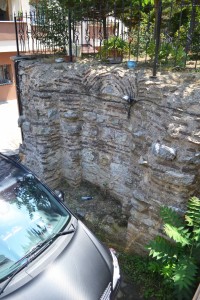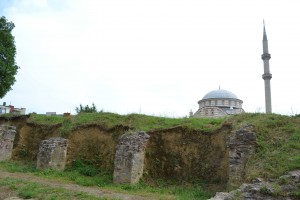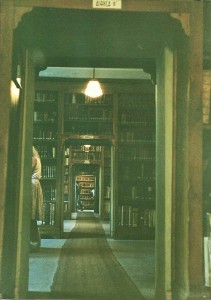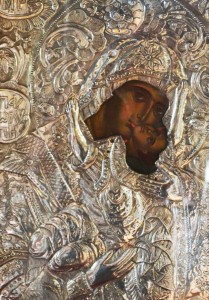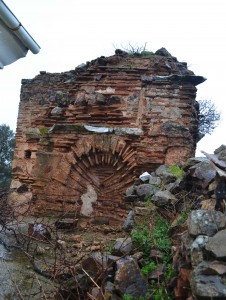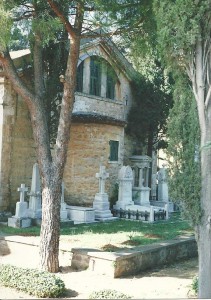
This is a thriving suburb in the Göztepe area. A Byzantine wall in the car park of an apartment block (40.988698,29.077986) has been identified as part of one of the many monasteries in the Diocese of Chalcedon. But these days, it’s just a bit of an obstruction to people trying to park their cars.
At the bottom of the hill, there are substantial bits of a cistern that form part of the car park wall of the new Medical Park Hospital. Staff on their cigarette breaks revel in the Byzantine surroundings.
Posted June 25, 2014 Posted by Adam in Uncategorized
This is a remarkable site (40.943748,29.115137) that has fallen victim to the tendency to establish a project with huge fanfare, then leave it to crumble when the money runs out. It’s still an amazing place. Essentially, the site is a raised platform of about 60m by 40m. The excavated section appears to be bounded by the walls of a collapsed cistern, once consisting of columns supporting rows of domes. The information on site says three rows of domes although it looks like four to me. The part on the east has an impressive single dome which is still standing. On top of this (and resting on the same four piers as supported this eastern dome) was constructed a large church with a dome about ten metres in diameter.
As usual, there is conjecture over the name and function of the building. One faction suggests that the church is part of the Palace of Bryas, built in 834 by the Emperor Theophilus. However, the Italian team that investigated the site in 2002 found evidence that this building is from the second half of the ninth century. It may be the church of the Monastery of Satyros, which was apparently quite close to Bryas Palace. It is doubtful whether the identity of the church will ever be settled.
In the meantime, anyone can get in. It’s a bit difficult to enter the large domed cistern but the rest is fair game. Small children play football against the outside walls and teenagers gather on the high walls after school. Remarkably, graffiti and incidental damage are minimal.

13th – 14th century earthenware pitcher with sgrafitto decoration, from Küçükyalı. Istanbul Archaeological Museum.
No Author listed. (2002) Maltepe’deki arkeolojik kazıdan kilise mi saray mı tartışması çıktı. Arkitera Bilgi Hizmetleri Available online at: http://v3.arkitera.com/v1/haberler/2004/12/30/maltepe.htm Accessed 10th Aug 2016
Kayar, A. (2005) Bizans prensinin manastırı Türkiye’nin ilk arkeolojik parkı olacak Hürriyet. Available online at: http://www.hurriyet.com.tr/bizans-prensinin-
manastiri-turkiye-nin-ilk-arkeolojik-parki-olacak-342077 Accessed 10th Aug 2016
Ricci, A. (1996) The Road from Baghdad to Byzantium and the Case of the Bryas Palace. In Brubaker, L. (ed) Byzantium in the Ninth Century: Dead or Alive? Papers from the Thirtieth Spring Symposium of Byzantine Studies, Birmingham, March 1996. Ashgate – Variorum, Aldershot. Pages 131 – 149. Available online at: https://www.academia.edu/1164332/A._Ricci_The_Road_from_Baghdad_to_Byzantium_and_the_case_of_the_Bryas_Palace Accessed 2nd Aug 2016

Posted June 25, 2014 Posted by Adam in Uncategorized
The TAY website is dedicated to recording the destruction of Turkey’s archaeological treasures and makes melancholy reading. One of its less cheery articles concerns the stonework in Pendik which was investigated in 1973-75, identified as a Byzantine monastery and promptly buried beneath a new road bridge. Not a lot here now (40.891269,29.238836). When that column base disappears, it will just be a pile of rubble.

Posted June 25, 2014 Posted by Adam in Uncategorized
Once out of sight of the massive shipyards, Tuzla is revealed as a rather lovely seaside town. Two of the major streets close to the coast are named Manastır Caddesi and Papaz Çeşme Sokak. These promise rather more than they deliver. The visible remains comprise the foundations and lower wall of a rectangular building, hard against an IETT bus stop (40.817735,29.30132). This seems to have been the ayazma. The presence of undeveloped land surrounding it may be an indication that further traces of an extensive monastery cover a wide area.
On an island a few hundred metres off the coast of Tuzla are the well-preserved remains of the Byzantine Church of St. Glykeria (Hagia Glykeria Nesos, 40.791212,29.274938). However, the island is owned by Rahmi Koç and this limits access somewhat. The island may once have been called Incirli Adası but now is invariably called Koç Adası. There is some information here.

Posted June 25, 2014 Posted by Adam in Uncategorized
These are just the sorts of places where hermits like to build stone huts to assert their holiness. These were followed by monks who left traces of monasteries not only on the four major islands – Büyükada (Prinkipo or Pityades Megale), Heybeliada (Halki or Halkitis), Burgazada (Antigone) and Kınalıada (Proti) – but also any other bits of rock that could be colonised – Sivri (Oxya), Yassı (Plateia or Rhodussa), Sedef (Antherovitos or Terebinthodes), Tavşanlı (Neandros) and Kaşık (Pita or Pygos). These days, anyone going to the four main islands would hardly be escaping to the isolation essential for divine contemplation.
There is a lot of Constantinople under the surfaces of the main islands. Most of it is well hidden. Click on the following pictures for detail about the four main islands
1. Büyükada/Prinkipo
2. Heybeliada/Halki
3. Burgazada/Antigone
4. Kınalıada/Proti
There are bits of wall on the other islands that may be identified as Byzantine if you want to take a wild guess. I have not yet taken the step of commandeering a boat to go to the small islands. The lack of residents and visitors probably mean that more remains of the less that was once on them.
Just off the coast of Tuzla is an island owned by Rahmi Koç. This is luxuriously appointed with all of the accoutrements that one would expect of a billionaire’s hideaway – a pool, a mansion and a Byzantine church (40.791212,29.274938). I am not yet a close enough friend of Rahmi Bey to have been invited to the island to obtain a better quality photograph of the church. If you are reading this, Rahmi Bey, I would also like to speak to you about steam locomotives that have recently vanished from Halkalı and Çankırı.

« Previous Entries Next Entries »
